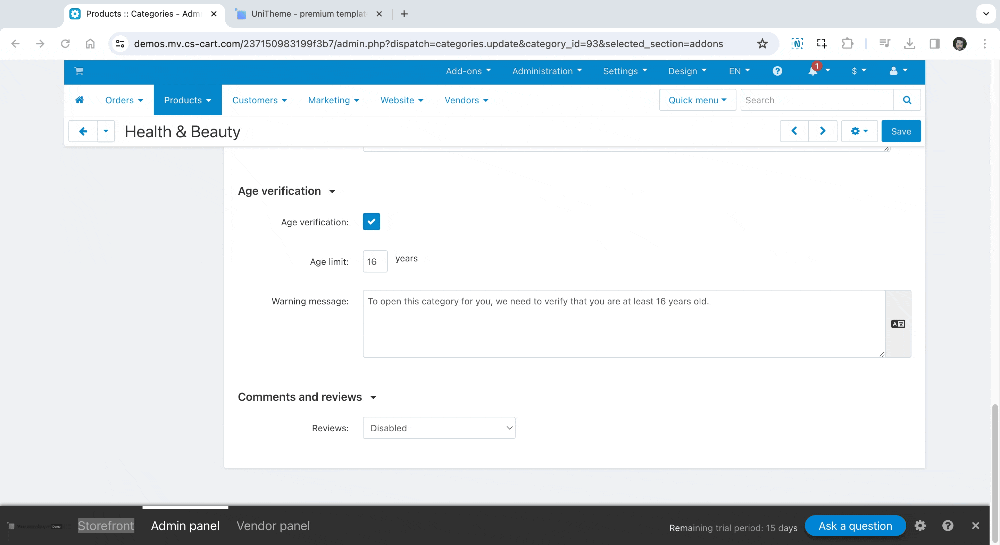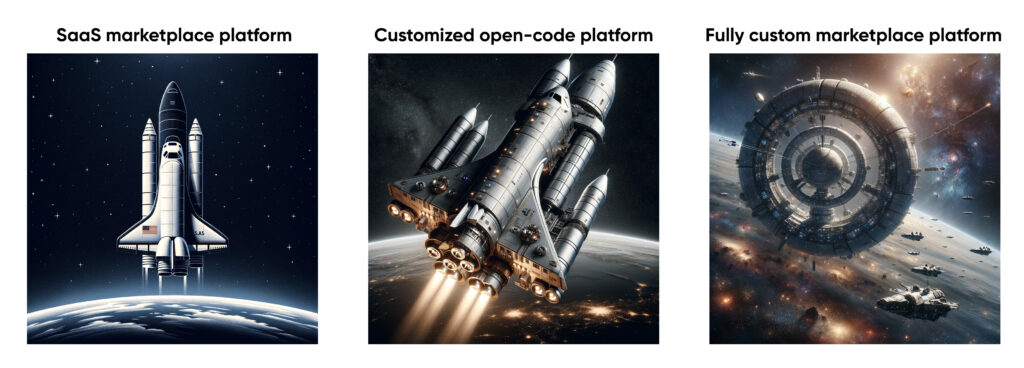Multi-Vendor Marketplace Development: How Much Does It Cost to Launch a Marketplace in 2024
Starting a multi-vendor marketplace without a clear budget is like going on a space journey without knowing how much fuel you have. You might start excited, but soon you’ll worry as fuel runs out way before you finish your journey. This shows why it’s so important to plan your resources carefully when going on a long trip—building a multi-vendor marketplace platform.

Developing a multi-vendor marketplace with just a rough idea of costs can seem easy at first. Early money might cover basic things like building the site and getting the word out. But, just like surprises on a journey that cost extra money, unexpected problems with your multi-vendor marketplace can eat up your budget fast.
There are plenty of cases where businesses failed because of poor financial planning. Take Lehman Brothers, which filed for bankruptcy in 2008 with $639 billion in assets and $619 billion in debt due to serious financial mismanagement and downplaying warning signs.
Or consider General Motors, which faced financial troubles in 2009 and had to file for bankruptcy due to years of declining sales, high labor costs, and poor strategic decisions.
This article will come in handy if you’ve already decided to develop your multi-vendor marketplace and are currently planning your budget. We’ll talk about expenditures and give you a fresh breakdown of marketplace development costs in 2024.
Table of Contents
- Ensuring Legal Compliance Before Starting Marketplace Development
- Considering the Development Strategy
- Breaking Down Marketplace Development Costs
- Considering Ongoing Operational Costs
- Case Study: Etsy’s Investment Strategy for Growth and Development
- Finalizing
- Q&A Section: Starting a Multi-Vendor Marketplace in 2024
Ensuring Legal Compliance Before Starting Marketplace Development
Developing a multi-vendor eСommerce marketplace requires careful planning and integration of key functionalities to ensure legal compliance. Here’s how to address these needs and the risks of overlooking them, with a focus on keeping your multi-vendor marketplace platform compliant and competitive:
1. Payment Gateway Integration
Why important: Secure payment gateways are essential for your multi-vendor marketplace. They must meet Payment Card Industry Data Security Standards (PCI DSS) to protect transactions. This keeps both customer and vendor data safe.
What if you don’t comply: You will face fines, lose the trust of your users, and even lose the ability to process payments.
2. Tax Calculation and Management System
Why important: Your multi-vendor marketplace platform needs an automatic system for calculating taxes. This system should handle different tax rates for various products and regions correctly.
What if you don’t comply: Getting taxes wrong can lead to fines and disputes with tax authorities. It can also upset customers charged the wrong amount on your multi-vendor eСommerce marketplace.
3. Data Protection and Privacy
Why important: Complying with data protection laws like GDPR or CCPA is crucial for multi-vendor marketplaces. You need to manage user data securely and ensure users can control their information.
What if you don’t comply: Ignoring these laws can result in huge fines and damage your marketplace’s reputation, driving users away.
4. Digital Accessibility
Why important: Making your multi-vendor marketplace accessible to people with disabilities is not just good practice—it’s often required by law. This means designing your site so everyone can use it easily.
What if you don’t comply: If your site isn’t accessible, you could face legal action and have to pay to make big changes to your multi-vendor marketplace platform.
5. Intellectual Property Protection
Why important: Protecting intellectual property on your platform is key. You need measures to prevent the sale of counterfeit goods and protect copyright.
What if you don’t comply: Allowing fake or pirated items can lead to legal trouble and harm the trust vendors and customers have in your multi-vendor marketplace.
6. User Agreement and Policies
Why important: Clear user agreements and privacy policies are essential. These documents should be easy to find and understand on your multi-vendor eCommerce marketplace.
What if you don’t comply: Without clear policies, you risk disputes and legal problems, which could force changes in how you operate your multi-vendor marketplace.
7. Age Restrictions and Content Filtering
Why important: For selling age-restricted products, your multi-vendor marketplace needs a reliable way to verify age and filter content appropriately.
What if you don’t comply: Failing to enforce age restrictions can lead to fines and damage your platform’s reputation among users and vendors alike.
Plan your development budget taking into account this functionality. Ignoring it can lead to legal, financial, and reputational damage, making it crucial to integrate these considerations into your development process from the start.

Considering the Development Strategy
Developing a multi vendor marketplace is like any good journey—it starts with choosing your path. Whether you’re looking to quickly test the waters, tailor-make your dream platform, or build something groundbreaking from the ground up, there’s a route for you. And of course each route has its cost.
We have a detailed guide on strategies for marketplace development—take a look. Here’s a breakdown so you get the idea:
1. SaaS Marketplace Platforms: Ideal for launching your multi-vendor eСommerce platform quickly with minimal upfront investment. Think of it as renting your online shop space—you get the keys, set up fast, and start with lower costs. Perfect for testing your multi-vendor marketplace idea without a huge commitment. Yet, customization is limited under the SaaS model, and as your marketplace grows, those subscription fees can increase.
2. Open-Code Platforms: Open-code platforms offer the freedom to customize your marketplace platform extensively. It’s like owning your store space, allowing you to remodel as you see fit. This path suits those looking to make their multi-vendor eСommerce platform stand out, though it demands more tech knowledge and a larger initial budget. You’re also in charge of maintenance, adding to your responsibilities.
3. Building From Scratch: For visionaries with specific needs and the resources to match, building your multi-vendor marketplace from zero offers complete control over design and functionality. It’s the path to creating a truly unique multi-vendor marketplace website, though it requires significant time and financial investment.

Breaking Down Marketplace Development Costs
Starting a multi-vendor eCommerce platform doesn’t come with a fixed price. The cost changes based on how complex your project is, how many special features you want, and how many extra services you need to add.
We’ll look at costs using a marketplace builder CS-Cart and services from Simtech Development, one of the top CS-Cart partners.
1. Custom Marketplace Development Costs
- MVP ($15,000 – $25,000): This step gets your multi-vendor website running. It covers basic setup on CS-Cart Multi-Vendor, focusing on essential eСommerce website features. This includes configuration of the built-in functionality and design, integration with payment systems, additional functionality of order delivery within selected time frames, and initial server setup.
- Marketplace with ERP Integration and Custom Basic Functionality ($50,000 – $100,000): Here, you integrate ERP software solutions for advanced inventory management, ensuring sellers can efficiently manage their stock. You’ll also add custom features, such as marketplace extensions, to enhance marketplace functionality and communication like SMS notifications.
- Fully Custom Project with Complex Integrations ($100,000 – $200,000): For a full-featured multi-vendor website, you’ll need to add advanced software for easy payment processing and lots of payment choices for your customers. You might also need special features made just for your site to help you make money in unique ways or to offer new services that set your marketplace apart.
2. Third-party Services Integration (avg. $3,500):
This includes adding external tools and software solutions to your platform for enhanced functionality, such as email marketing for promotions, live chat support for customer service, or financial software for easier bookkeeping.
3. Payment System Integration (from $1,200):
Integrating multiple payment options is crucial for convenient payment processing. This ensures customers can use their preferred payment method, whether it’s credit cards, PayPal, or newer digital wallets like crypto, enhancing the overall checkout experience.
4. Custom Design Creation (from $5,400):
A unique user interface design makes your multi-vendor platform visually appealing and easy to navigate. Custom design involves creating a distinctive look and feel that aligns with your brand, improving user engagement and making your marketplace memorable.
5. SEO Features (from $2,000):
Implementing SEO features is vital for making your eCommerce website easily discoverable online. This can include optimizing product descriptions for search engines, improving site speed for better user experience, and ensuring the site is mobile-friendly.
6. Custom Mobile App (native or PWA) (from $15,000):
Developing a custom mobile app (either a native app for iOS and Android or a Progressive Web App) extends the functionality of your marketplace to mobile users. This investment enhances accessibility and convenience, encouraging more engagement from shoppers and vendors.
7. Infrastructure and Server Audit (from $500):
Before launch, it’s important to ensure your multi-vendor eCommerce platform’s hosting infrastructure is robust and secure. An audit can identify potential issues with server capacity, security vulnerabilities, or performance bottlenecks, ensuring a smooth launch and reliable operation.
Investing in these areas lays a solid foundation for a successful multi-vendor marketplace. Each cost contributes to creating a platform that’s attractive to vendors and shoppers alike, balancing functionality, aesthetics, and performance.

“When customers approach us with questions like how much it would cost to develop a marketplace similar to Etsy, we dive deep into an investigation. There’s no fixed price tag because every project is unique, demanding different budgets,” explains Olga Belotskaya, an expert at Simtech Development. “We take the time to understand our customers’ goals, needs, and ideas, crafting the best development strategy and solutions tailored to them. At Simtech Development, we adopt a flexible pricing approach, treating each project and customer with the personalized attention they deserve.”
Breakdown of Approximate Marketplace Development Costs
| Development service | Cost |
| Marketplace MVP | $15,000 – $25,000 |
| Marketplace with ERP integration and custom basic functionality | $50,000 – $100,000 |
| Fully custom marketplace with complex integrations | $100,000 – $200,000 |
| Third-party services integration | avg. $3,500 |
| Payment system integration | from $1,200 |
| Custom design creation | from $5,400 |
| SEO features | from $2,000 |
| Custom mobile app (native or PWA) | from $15,000 |
| Infrastructure and server audit | from $2,000 |
Considering Ongoing Operational Costs
After your marketplace is up and running, there are ongoing costs you need to plan for. These keep your site working well and help it grow.
1. Maintenance, Updates, and Scaling:
- Costs: Costs for maintaining an eCommerce website can start from $10,000 per year for a medium-sized company.
- Why it’s important: Your site needs regular check-ups and fixes to work smoothly. As your marketplace grows, you’ll need to upgrade it so it can handle more vendors and customers.
2. Customer Support Infrastructure:
- Costs: This can vary, but setting aside $1,000 to $5,000 a month is a good start. If you’re planning to expand your customer service department, remember that hiring a customer service representative in the US can cost between $25,000 and $45,000 annually. Additionally, the average hourly rate for outsourced customer support services in the US varies from $15 to $25.
- Why it’s important: Good customer service keeps users happy. You need a team or tools to help answer questions and solve problems.
3. Marketing and Vendor Management Expenses:
- Costs: eCommerce companies typically spend between 6-20% of their gross revenue on marketing, with newer companies and those with less than $5 million in revenue potentially spending more. Vendor management might cost less but expect to spend based on the number of vendors.
- Why it’s important: Marketing gets your marketplace noticed. Managing vendors well ensures they’re happy and their products meet your standards.
Including these costs in your budget helps you keep your marketplace running without surprises. It’s all about planning ahead so you can focus on making your marketplace a success.
Case Study: Etsy’s Investment Strategy for Growth and Development
Etsy, well-known for its handmade and unique items, is a perfect example of how investing money wisely can boost a marketplace’s growth. Let’s dive into Etsy’s strategy and see what we can learn.
Big Spending on Marketing
In 2021, Etsy decided to significantly increase its marketing budget to $600 million. This wasn’t just throwing money around—it was a calculated move. They used this budget for TV ads, social media influencers, and billboards, aiming to bring more shoppers to their site.
Investing in Technology and Safety
Etsy also knows the importance of keeping the platform safe and easy for sellers to use. They spent about $40 million on improving their technology and making the marketplace safer. This includes giving sellers better tools to manage their shops and ensuring buyers have a positive experience.
Raising Fees for Future Growth
To support all these improvements, Etsy raised its transaction fee from 5% to 6.5%. This extra money isn’t just for the sake of it. It’s meant to fund more marketing, develop new seller tools, and enhance the shopping experience on Etsy. This way, they can bring even more buyers to the platform.
Keeping the Marketplace Trustworthy
Etsy is also focused on keeping the site trustworthy and supportive for sellers. Part of their investment goes into monitoring the marketplace for any listings that break the rules. They also provide help to sellers dealing with buyer issues, ensuring a smooth process for everyone involved.
The Big Picture
Etsy’s actions tell us a lot about growing a successful marketplace. By putting money into marketing, technology, and customer support, Etsy keeps drawing in more customers and supporting sellers. This balanced approach to investment and improvement is a key part of why Etsy continues to succeed. It’s a lesson in how spending in the right areas can make a marketplace not just bigger, but better for everyone involved.
Finalizing
Developing a multi-vendor marketplace in 2024 is a complex, costly, but rewarding venture. Key takeaways include:
- Plan Your Budget: Understand that costs vary widely. There’s no one-size-fits-all price for building a marketplace. Factors like project complexity, custom features, and integrations play a significant role in determining the final cost.
- Consider Development Options: Whether using a SaaS platform, an open-code solution, or building from scratch, each choice has its own set of costs and benefits. Choose the path that aligns with your business goals and budget.
- Don’t Forget Ongoing Costs: Maintenance, updates, customer support, and marketing are crucial for the long-term success of your marketplace. These ongoing operational costs should be included in your initial budget planning.
- Legal Compliance is Crucial: Ensuring your marketplace meets legal requirements is not optional. Investment in compliance will save you from potential fines and legal issues.
Remember, investing in a multi-vendor marketplace is not just about launching it but also about sustaining and growing it. Careful planning, strategic investment, and constant improvement are key to turning your marketplace into a thriving online community.
Discover the cost of developing your marketplace:
Q&A Section: Starting a Multi-Vendor Marketplace in 2024
Q1: What makes the cost of starting a multi-vendor marketplace go up or down in 2024?
A1: The cost to start a multi-vendor marketplace website in 2024 changes based on a few big things. This includes the type of multi-vendor marketplace software you choose (like SaaS, open-code, or something made just for you), how complex your site is, following laws for online marketplaces, adding different ways to pay, making the site look good and easy to use, getting your site found on Google, and keeping your site running smoothly and safely.
Q2: How do laws like GDPR, CCPA, and PCI DSS change the cost of running a multi-vendor marketplace?
A2: Following laws for data safety and payments is a big deal for online marketplaces. It means spending money on secure payment systems and keeping customer information safe. If you don’t, you could face big fines and lose your customers’ trust, which could cost you even more in the long run.
Q3: What’s the difference in cost and benefits between using a SaaS platform, open-code, or building from scratch for my multi-vendor marketplace?
A3: Choosing a SaaS platform for your multi-vendor marketplace solution can save you money upfront and get your marketplace owners selling faster, but you might not be able to change things as much as you want. Open-code lets you customize more, but it costs more and you need to know how to keep it running. Building a multi-seller marketplace platform from scratch gives you all the control but takes a lot of time and money.
Q4: What are some surprises and tough parts about making a multi-vendor marketplace?
A4: When building a multi-vendor marketplace model, you might run into issues like adding many ways to pay, meeting legal rules in different places, keeping the site safe, and setting up taxes right. Costs can go up unexpectedly if you need to add more features, pay more for keeping the site running, or deal with legal stuff you didn’t expect.
Q5: How does adding different payment options affect my multi-vendor marketplace?
A5: Having various payment options is key for a good shopping experience in multi-vendor marketplaces. It makes shoppers happy and builds trust in your online marketplace. If it’s not done right, it can cause problems with payments and make people think twice about your marketplace.
Q6: Why is SEO important for my multi-vendor marketplace, and how much should I spend on it?
A6: SEO helps people find your multi-vendor marketplace website easily on Google, bringing more visitors and sales. Spending money on SEO means making sure your site and products show up in searches, works fast, and looks good on phones. It’s a must for growing your site and should be part of your budget from the start.
Q7: Looking at Etsy, how crucial is marketing for growing a multi-vendor marketplace, and what should my budget be?
A7: Just like Etsy, spending on marketing is super important for getting more buyers and sellers to your online marketplace. How much you spend can change based on how big your marketplace is and who you want to reach, but usually, it’s between 6-20% of what you make. Start-ups might spend more to get noticed. This money goes into ads online, social media, blogs, and working with influencers to get the word out to your target audience.
Yan Anderson is the Head of Content Marketing at CS-Cart with over 10 years of experience in the eCommerce industry. He's passionate about explaining complicated things in simple terms. Yan has expertise in building, running and growing eCommerce marketplaces. He loves to educate people about best practices, new technologies, and trends in the global eCommerce industry.

